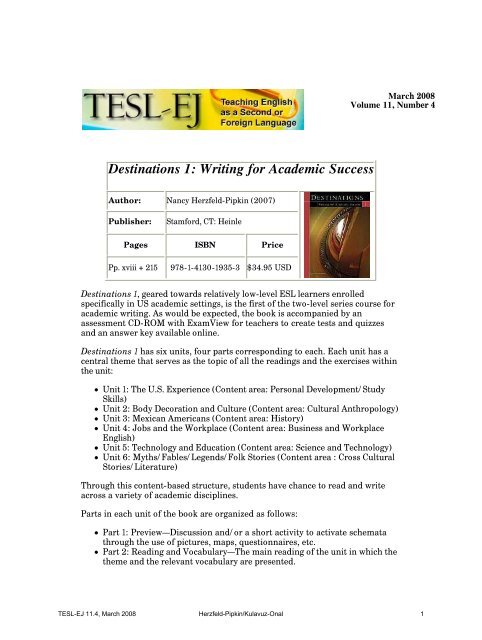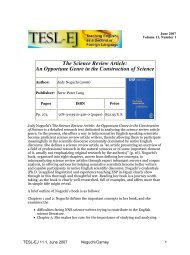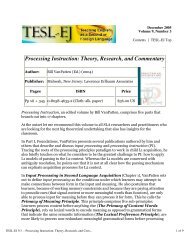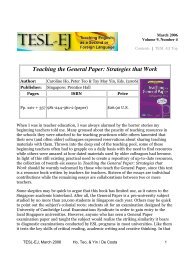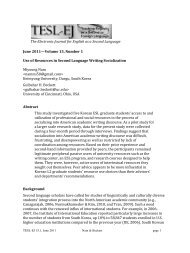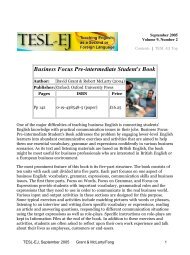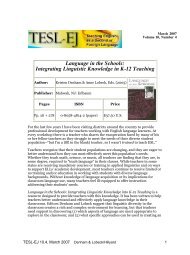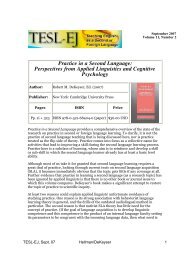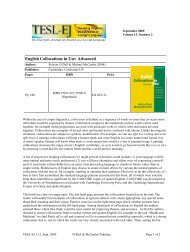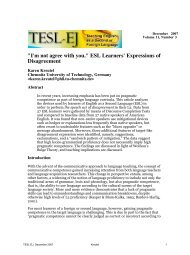TESL-EJ 11.4 -- Destinations 1: Writing for Academic Success
TESL-EJ 11.4 -- Destinations 1: Writing for Academic Success
TESL-EJ 11.4 -- Destinations 1: Writing for Academic Success
Create successful ePaper yourself
Turn your PDF publications into a flip-book with our unique Google optimized e-Paper software.
March 2008<br />
Volume 11, Number 4<br />
<strong>Destinations</strong> 1: <strong>Writing</strong> <strong>for</strong> <strong>Academic</strong> <strong>Success</strong><br />
Author: Nancy Herzfeld-Pipkin (2007)<br />
Publisher:<br />
Stam<strong>for</strong>d, CT: Heinle<br />
Pages ISBN Price<br />
Pp. xviii + 215 978-1-4130-1935-3 $34.95 USD<br />
<strong>Destinations</strong> 1, geared towards relatively low-level ESL learners enrolled<br />
specifically in US academic settings, is the first of the two-level series course <strong>for</strong><br />
academic writing. As would be expected, the book is accompanied by an<br />
assessment CD-ROM with ExamView <strong>for</strong> teachers to create tests and quizzes<br />
and an answer key available online.<br />
<strong>Destinations</strong> 1 has six units, four parts corresponding to each. Each unit has a<br />
central theme that serves as the topic of all the readings and the exercises within<br />
the unit:<br />
Unit 1: The U.S. Experience (Content area: Personal Development/Study<br />
Skills)<br />
Unit 2: Body Decoration and Culture (Content area: Cultural Anthropology)<br />
Unit 3: Mexican Americans (Content area: History)<br />
Unit 4: Jobs and the Workplace (Content area: Business and Workplace<br />
English)<br />
Unit 5: Technology and Education (Content area: Science and Technology)<br />
Unit 6: Myths/Fables/Legends/Folk Stories (Content area : Cross Cultural<br />
Stories/Literature)<br />
Through this content-based structure, students have chance to read and write<br />
across a variety of academic disciplines.<br />
Parts in each unit of the book are organized as follows:<br />
Part 1: Preview—Discussion and/or a short activity to activate schemata<br />
through the use of pictures, maps, questionnaires, etc.<br />
Part 2: Reading and Vocabulary—The main reading of the unit in which the<br />
theme and the relevant vocabulary are presented.<br />
<strong>TESL</strong>-<strong>EJ</strong> <strong>11.4</strong>, March 2008 Herzfeld-Pipkin/Kulavuz-Onal 1
Part 3: <strong>Writing</strong> Sentences—<strong>Writing</strong> presented and practiced at the sentence<br />
level.<br />
Part 4: <strong>Writing</strong>—<strong>Writing</strong> presented and practiced at the paragraph level.<br />
<strong>Destinations</strong> 1 does not follow a linear order in which the students are presented<br />
with explanation and practice of all the sentence patterns be<strong>for</strong>e they move on to<br />
paragraph writing. Rather, they start reading and writing paragraphs as well as<br />
dealing with different sentence structures and editing from the very first unit of<br />
the book.<br />
The strongest aspect of the book is that, in each unit, the first two parts equip<br />
students with extensive background knowledge about the theme through reading<br />
and vocabulary practice be<strong>for</strong>e they are ready to write. Also, students' knowledge<br />
about the content is developed even further with approximately 3-4 short<br />
readings (even more in Units 3 and 6) presented in the writing sections. In that<br />
sense, although this book is mainly intended to teach writing, it can as well be<br />
regarded as an integrated academic reading and writing book. This integration<br />
can also be seen in the design of the writing sections, exercises and prompts: all<br />
are aimed at eliciting what students have been absorbing of the reading passages<br />
and vocabulary. In turn, such rein<strong>for</strong>cement could contribute to vocabulary<br />
building and retention. For example, after having read extensively about "Body<br />
Decoration" in Unit 2, learned relevant vocabulary and done controlled and<br />
semi-controlled exercises on that theme, students are asked at the end of the unit<br />
to write a paragraph describing their or their culture's body art or a ceremony<br />
with body art.<br />
At the end of each section in a unit, students are encouraged to write on or<br />
discuss two theme-related questions. While these give students opportunities to<br />
develop ideas through speaking or in<strong>for</strong>mal writing, the "<strong>Writing</strong> assignment"<br />
section closing each unit are the places where students develop an organized<br />
paragraph after they have gained enough background knowledge through each<br />
unit's readings on the theme. Thus, specifically in this section, students are<br />
encouraged to write, give/get feedback, and revise what they have written,<br />
steered along by checklists and guidelines in a continuous process. Lastly,<br />
different paragraph structures are presented to students visually in charts at the<br />
end of each unit. These reproducible organization charts act like pre-writing<br />
devices or graphic organizers, making it easier <strong>for</strong> students to organize their<br />
thoughts be<strong>for</strong>e writing their first drafts.<br />
Admirably, Herzfeld-Pipkin fosters multiple-step peer reviewing. Students first<br />
have to review and give feedback to their partners on their organization charts<br />
be<strong>for</strong>e they write their first draft. For the students to proceed smoothly, the<br />
author has included peer review sheets <strong>for</strong> both the organization charts and the<br />
first drafts of the students' paragraphs. Given the proficiency level of the<br />
students targeted in this book and speaking from experience, though, I would<br />
rewrite these review sheets in a shorter <strong>for</strong>mat with clear-cut, direct questions if<br />
I was to use them with my students.<br />
It is obvious that the book assumes a multicultural and multinational classroom,<br />
as the writing prompts are mostly directed to students' own native culture. For<br />
example, on page 84, in a Discussion/<strong>Writing</strong> section, question 2 asks students<br />
to "name one famous person from [your] own native culture" and on page 34, in<br />
<strong>TESL</strong>-<strong>EJ</strong> <strong>11.4</strong>, March 2008 Herzfeld-Pipkin/Kulavuz-Onal 2
a Quickwrite/Freewrite section, one of the questions asks whether or not "the<br />
people in [your] native culture use any of the same kinds of body art or<br />
decoration seen in the photos." To use this book in other settings, I believe that it<br />
would need to be supplemented and/or modified—<strong>for</strong> example, if it was to be<br />
used in a monolingual EFL classroom if or when the majority of the students<br />
share most aspects of the predominant culture. Nevertheless, learning about<br />
other cultures and the U.S.A. through the readings in the book might be tempting<br />
<strong>for</strong> at least some EFL students.<br />
Although the book would really be an asset to an ESL multicultural classroom in<br />
terms of the points discussed above, it still has some minor weaknesses which<br />
need to be touched upon. The layout of <strong>Destinations</strong> 1 is somewhat difficult to<br />
follow, perhaps giving the reader some trouble finding the section of interest.<br />
One reason <strong>for</strong> this could be that the font size and font style are the same <strong>for</strong> all<br />
the subheadings, explanations and directions. Moreover, directions <strong>for</strong> the<br />
exercises are too long and complicated, making them difficult to understand <strong>for</strong><br />
a low-level ESL learner. In addition, while the maps, pictures and photos<br />
supplementing the readings help activate students' schemata be<strong>for</strong>e reading and<br />
add a visual dimension to the book, students might find the book more appealing<br />
and note the contrast to the written text if the author had chosen color visuals<br />
instead of black-and-white ones.<br />
One other drawback: When I first came across the "Skills Index" at the back of<br />
the book, I had expected to find writing skills such as "developing a topic<br />
sentence", "introducing an example as a supporting sentence", etc. Instead, this<br />
index provides an alphabetical listing where one finds a predominance of entries<br />
about grammar such as "articles" and "dependent clauses", which may cause<br />
confusion <strong>for</strong> the reader/user. For this reason, calling it "Subject" or "Topic"<br />
index wouldn't mislead.<br />
To my mind <strong>Destinations</strong> 1 would work best in ESL classes in the U. S. with a<br />
student population from a wealth of cultures and backgrounds. There's<br />
something in the content here <strong>for</strong> every potential student in such a setting.<br />
Derya Kulavuz-Onal<br />
University of South Florida<br />
<br />
© Copyright rests with authors. Please cite <strong>TESL</strong>-<strong>EJ</strong> appropriately.<br />
<strong>TESL</strong>-<strong>EJ</strong> <strong>11.4</strong>, March 2008 Herzfeld-Pipkin/Kulavuz-Onal 3


